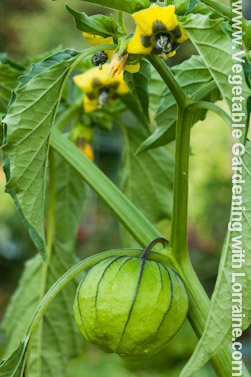- Home
- How to Grow Vegetables A-Z
- Growing Tomatillos
Growing Tomatillos
How to Grow Tomatillos
The Mexican Weed of Traditional Salsa Verde
My first experience growing tomatillos didn’t work out so well. I bought a beautiful healthy 10” tall start from Home Depot, brought it home and planted it, and it grew, and grew, and grew. And then it grew some more.
By the end of the summer, it was a sprawling, 4’ high by 5’ across plant with a 2” thick woody stem, and not a single tomatillo in sight.
The poor thing was lonely. No one told me this odd fact: tomatillos cannot self-pollinate. You must grow two or more plants in order for them to produce fruits.
Brief History of Growing Tomatillos
The tomatillo is in the “solanacea” family, which makes it related to tomatoes, eggplants, peppers and potatoes. The fruit looks a bit like a small tomato, except it grows inside a husk that makes it look like a little Chinese lantern.
There are two tomatillo species, both of which are native to Mexico and grow as “volunteers” all over that country. To keep from having to wander around harvesting them, the Aztecs domesticated them, planting them in patches so they could harvest them fresh when needed for salsa verde. (I wonder if they had tortilla chips?)
From these two species, different cultivars have been developed, in green, yellow and purple colors. Traditional green salsa is made with slightly unripe tomatillos and has a deliciously tart, slightly acidic bite. Ripe yellow or purple tomatillos make slightly sweeter and milder salsas. The best green chili is also rich with tomatillos.
Best Conditions for Growing Tomatillos
Like eggplants and tomatoes, tomatillos like it hot and sunny! If you live in a region with winters, you can start tomatillos indoors under bright lights up to 8 weeks before your last frost date, but don’t transplant them out until the soil is good and warm - at least 50°F. (60's or above is better, and probably will increase overall harvest.)
Like some tomatoes, tomatillos are “indeterminate”, which means they will sprawl out all over the place if you don’t contain them in a cage (big tomato cages work fine), and encourage them to grow up instead of out.
Give them about 2 feet of space each if you use cages, or 3-4 feet if you let them sprawl. Plant the seeds about ¼” deep in seed flats if starting indoors, or directly in the garden if you wait until after the soil has warmed.
Being a bit of a wild and weedy plant, tomatillos are not heavy feeders, but do appreciate a bit of compost dug in at the time of planting.
Growing Tomatillos: Bugs and Other Strangers
Tomatillos have very little trouble with pests. They may occasionally get hit with the fungal disease “early blight” if they stay too damp around the base. Don’t overwater them, and water them from below if possible (I’m not a fan of overhead watering on squashes, tomatoes or tomatillos because they are so susceptible to powdery mildew and blights). Using cages to keep them up off the ground also helps prevent blight.
Why isn’t overhead watering the same as rain? Because a ninety-degree, full-sun day shining on sopping wet leaves is not the same as a cooler, cloudier rainy day. The combination of heat and wet tends to bring on powdery mildew and other fungal diseases.
Harvesting Tomatillos
Tomatillos are often harvested unripe, since part of what they bring to the table is that special tartness.
The bigger varieties like the traditional Mexican Green Husk, will burst the husk when they get 2" across and are ripe. The smaller varieties like the wild Purple de Milpe don't break the husk, and you should harvest them when they reach whatever size is described on the seed packet (in the purple's case, about 3/4").
They will keep at room temperature for about a week, or 2-3 if you keep them in the fridge. For the longest storage life, pull up the entire plant by the root when most fruits are ripening, shake off the dirt, and hang them upside down in a cool place, like an unheated basement or (non-freezing) garage. Or, for the really longest storage life, make salsa verde and can or freeze it!
Happy vegetable gardening!
Help share the skills and spread the joy
of organic, nutrient-dense vegetable gardening, and please...
~ Like us on Facebook ~
Thank you... and have fun in your garden!
Affiliate Disclaimer
This website contains affiliate links to a few quality products I can genuinely recommend. I am here to serve you, not to sell you, and I do not write reviews for income or recommend anything I would not use myself. If you make a purchase using an affiliate link here, I may earn a commission but this will not affect your price. My participation in these programs allows me to earn money that helps support this site. If you have comments, questions or concerns about the affiliate or advertising programs, please Contact Me.Contact Us Page




